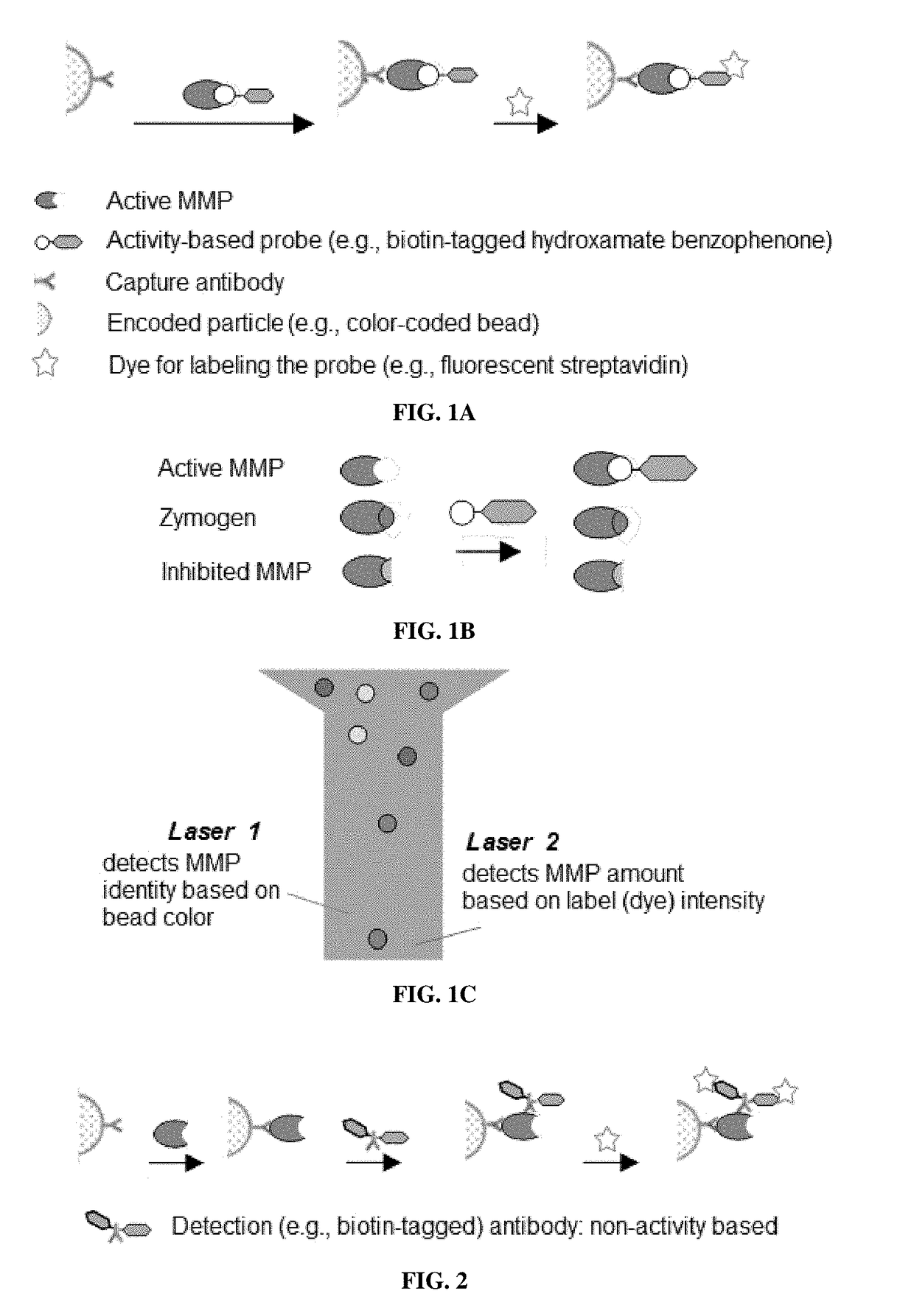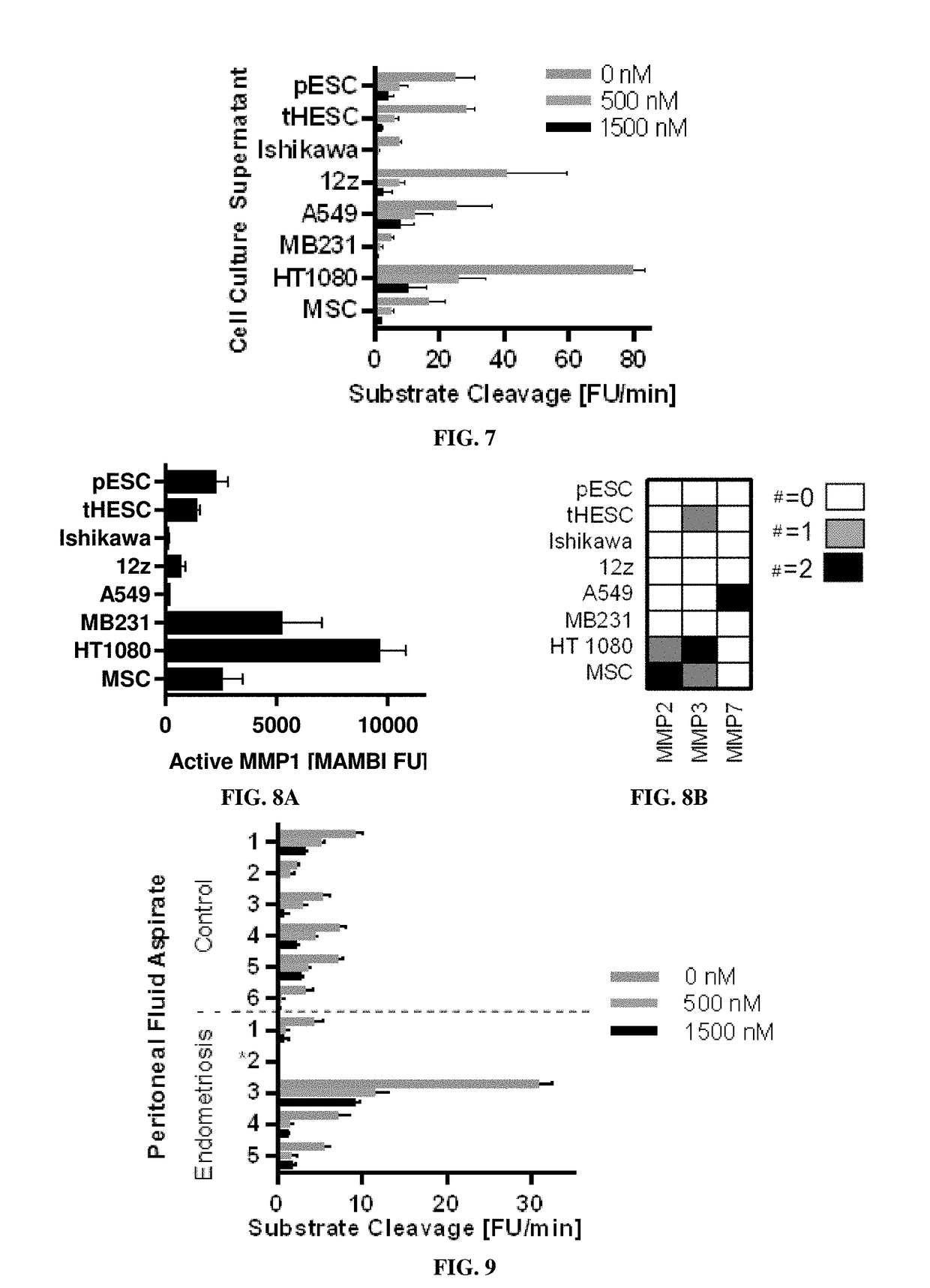Compositions and multiplex assays for characterizing active proteases and their inhibitors
a technology of active proteases and inhibitors, applied in the field of high throughput profiling or screening, can solve the problems of preventing the functional analysis of metalloproteases, unable to monitor and modulate one or two enzymatic activities, and unable to deliver therapeutic efficacy,
- Summary
- Abstract
- Description
- Claims
- Application Information
AI Technical Summary
Benefits of technology
Problems solved by technology
Method used
Image
Examples
example 1
n of MAMBI Selectivity for Quantifying Active MMPs
[0170]Materials
[0171]Recombinant human enzymes MMPs 1, 2 and 3 and TIMP2 were purchased from Peprotech. The recombinant catalytic domains of human MMPs 7 and 9 were purchased from Enzo Life Sciences, and of MMP 12 from Anaspec. FRET-substrates were purchased from BioZyme, Inc. Streptavidin-R-Phycoerythrin (Ref. PJRS25) was purchased from ProZyme. Human Active MMP 1 and MMP 9 Fluorokine E kits were purchased from R&D Systems. MMP capture beads for MMPs 1, 2, 3, 7, 10 and 12 were purchased from R&D Systems (Human MMP Magnetic Luminex Performance Assays), and those for MMP 9 from Bio-Rad (Bio-Plex Pro Human MMP-9 Singleplex Set Ref. 171BM006M). Antibody-based bead capture was performed using reagents in the Human Magnetic Luminex Performance Assay Base Kit, MMP Panel (R&D Systems, Ref. LMPM000).
[0172]Methods
Synthesis of an Activity-Based Probe
[0173]A trifunctional, biotin-tagged hydroxamate benzophenone (HxBP-Bt) probe (containing a PEG...
example 2
Sensitivity and Linear Range of MAMBI Detection of Active MMPs
[0192]Dilutions of active recombinant proteases to known concentrations and testing them in the MAMBI system determined the sensitivities and linear ranges of MAMBI detection. All dilutions were performed with a background of 1% BSA.
[0193]Table 2 shows the capture beads targeting MMPs 1 and 7 in a MAMBI system had a wide detection range, and all assayed capture beads demonstrated consistently low background fluorescent intensities.
TABLE 2The range of linear relationship between the detection signal in theexemplified MAMBI system and the concentration of active MMPs.Recombinant MMP MAMBILinear Range of DetectionMMPMin FUMax FU18040,00028043036026076518,00097082012150284
[0194]The absolute sensitivity of MAMBI detection for each target MMP was approximated based on the absolute concentration of the standard diluent at the limit of detection (LoD). The molar concentrations of active MMP in diluted standards were estimated in ...
example 3
ation and Quantification of Active MMPs in Conditioned Media (Supernatants from Cell Cultures) Responsible for Proteolytic Activity
[0197]Materials & Methods
[0198]Eight conditioned mediums were assayed, each tested in two complete biological replicates (n=2), from these cell cultures: four endometrial related cell populations including (1) primary endometrial stromal cells (pESC), (2) telomerase-immortalized human endometrial stromal cells (tHESC) (Krikun et al., Endocrinology, 145(5):2291-6 (2004)), (3) an adenocarcinoma endometrial epithelial cell line, Ishikawa, and (4) an epithelial line derived from an endometriosis lesion, 12z; three canonical cancer cell lines including (5) A549, (6) MD-MBA-321, and (7) HT1080; as well as (8) human telomerase reverse transcriptase (hTERT) immortalized mesenchymal stem cell line (MSC).
[0199]Conditioned supernatant was prepared: collected at 12 h, spun down at 200 g for 5 min to remove debris, and immediately flash-frozen. For FRET-substrate ass...
PUM
| Property | Measurement | Unit |
|---|---|---|
| freezing temperature | aaaaa | aaaaa |
| freezing temperature | aaaaa | aaaaa |
| freezing temperature | aaaaa | aaaaa |
Abstract
Description
Claims
Application Information
 Login to View More
Login to View More - R&D
- Intellectual Property
- Life Sciences
- Materials
- Tech Scout
- Unparalleled Data Quality
- Higher Quality Content
- 60% Fewer Hallucinations
Browse by: Latest US Patents, China's latest patents, Technical Efficacy Thesaurus, Application Domain, Technology Topic, Popular Technical Reports.
© 2025 PatSnap. All rights reserved.Legal|Privacy policy|Modern Slavery Act Transparency Statement|Sitemap|About US| Contact US: help@patsnap.com



